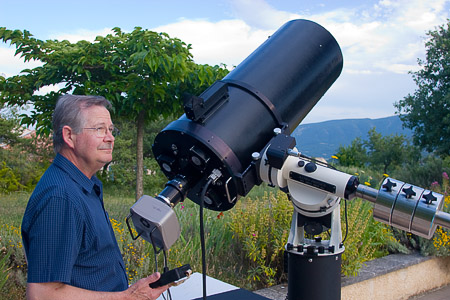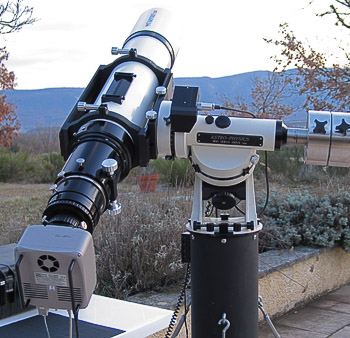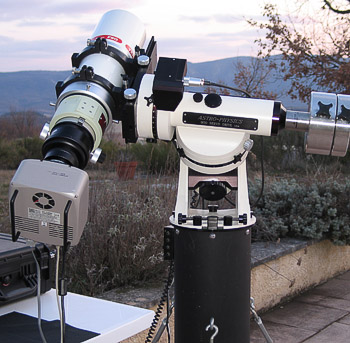 I
have been interested in astronomy since about the age of twelve, when I can
remember reclining full length on the dew-laden lawn of my parent's house
in Parkstone, Dorset, trying to spot the polar caps of Mars through a 2"
non-achromatic refractor I was given for my birthday.
I
have been interested in astronomy since about the age of twelve, when I can
remember reclining full length on the dew-laden lawn of my parent's house
in Parkstone, Dorset, trying to spot the polar caps of Mars through a 2"
non-achromatic refractor I was given for my birthday.
My interest waned somewhat during my later teens, 20's and 30's (a misspent youth and subsequent preoccupations with career and family seemed to be the main cause), but re-emerged strongly in 1988 when I purchased my first 'real' telescope - a Meade 8" LX3. It was with this telescope that I started to dabble in astrophotography, but went on to more serious things in 1994 with the acquisition of a Meade LX200 10".
I started to become seriously involved in astrophotography in December 1996. To support the quality I require I started making regular astrophotography trips to the south of France, however many of my images continue to made from the back garden of my house in Wiltshire, UK. During 1997 I acquired various accessories and lenses (listed below) to help support astrophotography.
 During
1998 I replaced my Tamron 300mm lens with Nikon 300mm and 400mm lenses and
upgraded my hypering kit to support high vacuum film hypersensitisation. During
my first two years of experience in astrophotography I became increasingly
aware of the need to cover focal lengths in the 1000mm range. Therefore late
in 1998 I made two major acquisitions: an AP 900 GTO mount and an AP 155 EDF
f/7 refractor with 4" Field Flattener - both of these are shown on the
right. A little later I also acquired a Pentax 6x7 camera to enable medium
format photography with the new refractor. At this time most of my photography
was done on either gas hypersensitised Kodak Ektapress Multispeed film, or
Kodak GPY 120 format (in the case of medium format).
During
1998 I replaced my Tamron 300mm lens with Nikon 300mm and 400mm lenses and
upgraded my hypering kit to support high vacuum film hypersensitisation. During
my first two years of experience in astrophotography I became increasingly
aware of the need to cover focal lengths in the 1000mm range. Therefore late
in 1998 I made two major acquisitions: an AP 900 GTO mount and an AP 155 EDF
f/7 refractor with 4" Field Flattener - both of these are shown on the
right. A little later I also acquired a Pentax 6x7 camera to enable medium
format photography with the new refractor. At this time most of my photography
was done on either gas hypersensitised Kodak Ektapress Multispeed film, or
Kodak GPY 120 format (in the case of medium format).
 In
October 2000 I replaced my 10" LX200 OTA with a 12.5" Ritchey-Chretien
from RC Optical Systems to support higher quality in wide field photography.
The RC has other advantages, such as 1/6 wave optics, a superb focusing system,
and very good thermal stability (the focus does not shift during the night).
A little later, in February 2001, I made a move into CCD imaging with the
purchase of an SBIG ST-8E camera. This served its purpose well for may years
but ultimately I could not ignore the lure of "full format" and
in 2007 I replaced it with the SBIG STL-11K. In 2008 I acquired the Takahashi
FSQ-106ED with f/3.6 reducer to cover the all-important range from 300-500mm!
This is an optically exquisite instrument and the fast f/ratio makes it a
joy to use for all the wide field objects. But I musn't forget the AP155 EDF
which also has superb optics and has been my workhorse imaging telecope since
2000.
In
October 2000 I replaced my 10" LX200 OTA with a 12.5" Ritchey-Chretien
from RC Optical Systems to support higher quality in wide field photography.
The RC has other advantages, such as 1/6 wave optics, a superb focusing system,
and very good thermal stability (the focus does not shift during the night).
A little later, in February 2001, I made a move into CCD imaging with the
purchase of an SBIG ST-8E camera. This served its purpose well for may years
but ultimately I could not ignore the lure of "full format" and
in 2007 I replaced it with the SBIG STL-11K. In 2008 I acquired the Takahashi
FSQ-106ED with f/3.6 reducer to cover the all-important range from 300-500mm!
This is an optically exquisite instrument and the fast f/ratio makes it a
joy to use for all the wide field objects. But I musn't forget the AP155 EDF
which also has superb optics and has been my workhorse imaging telecope since
2000.
The photographs on this page show the three primary telescopes mounted on
the AP900 GTO and in each case the SBIG STL-11K is coupled as the imaging
instrument. They are:
Top: RCOS 12.5" Ritchey-Chretien f/9 reflector
Left: Takahashi FSQ-106ED f/5 Apochromatic Refractor (f/3.6 with reducer)
Right: AP 155 EDF f/7 Apochromatic Refractor
My astronomical and photographic equipment consists of:
Image Acquisition:AP 900 GTO Mount, Takahashi FSQ-106ED, AP 155 EDF refractor with 4" Field Flattener, RC Optical Systems 12.5" f/9 Ritchey-Chretien, Nikon 300mm f/2.8 lens, Nikon 180mm f/2.8 lens, SBIG STL-11K camera, SBIG ST-4 autoguider, Pentax 6x7 camera, and the usual endless assortment of tripods and accessories.
Image Processing: Dell XPS 700 Workstation 4Gb RAM / Adobe Photoshop CS4, MaximDL, AIP4WIN, Registar, Iris, CCDOps, CCDSharp, Picture Window from Digital Light & Color, Polaroid Sprintscan 45 Ultra, Polaroid Sprintscan 35 Plus.
I am grateful to the many friends on mail lists such as APML and SBIG who have given me invaluable help. Mail lists are a wonderful thing - there is more knowledge and experience to be had than in any book, and it's totally free. Without this help I would still be in the proverbial dark ages.